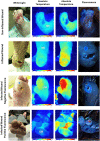Is my wound infected? A study on the use of hyperspectral imaging to assess wound infection
- PMID: 37692790
- PMCID: PMC10483069
- DOI: 10.3389/fmed.2023.1165281
Is my wound infected? A study on the use of hyperspectral imaging to assess wound infection
Abstract
Introduction: Clinical signs and symptoms (CSS) of infection are a standard part of wound care, yet they can have low specificity and sensitivity, which can further vary due to clinician knowledge, experience, and education. Wound photography is becoming more widely adopted to support wound care. Thermography has been studied in the medical literature to assess signs of perfusion and inflammation for decades. Bacterial fluorescence has recently emerged as a valuable tool to detect a high bacterial load within wounds. Combining these modalities offers a potential objective screening tool for wound infection.
Methods: A multi-center prospective study of 66 outpatient wound care patients used hyperspectral imaging to collect visible light, thermography, and bacterial fluorescence images. Wounds were assessed and screened using the International Wound Infection Institute (IWII) checklist for CSS of infection. Principal component analysis was performed on the images to identify wounds presenting as infected, inflamed, or non-infected.
Results: The model could accurately predict all three wound classes (infected, inflamed, and non-infected) with an accuracy of 74%. They performed best on infected wounds (100% sensitivity and 91% specificity) compared to non-inflamed (sensitivity 94%, specificity 70%) and inflamed wounds (85% sensitivity, 77% specificity).
Discussion: Combining multiple imaging modalities enables the application of models to improve wound assessment. Infection detection by CSS is vulnerable to subjective interpretation and variability based on clinicians' education and skills. Enabling clinicians to use point-of-care hyperspectral imaging may allow earlier infection detection and intervention, possibly preventing delays in wound healing and minimizing adverse events.
Keywords: bacteria; fluorescence; hyperspectral imaging; infection; inflammation; point-of-care; thermography; wounds.
Copyright © 2023 Ramirez-GarciaLuna, Martinez-Jimenez, Fraser, Bartlett, Lorincz, Liu, Saiko and Berry.
Conflict of interest statement
JR-G, AL, RB, and GS are former employees of Swift Medical, Inc. RF and ZL are current employees of Swift Medical, Inc. AL was employed by company Vope Medical. The remaining authors declare that the research was conducted in the absence of any commercial or financial relationships that could be construed as a potential conflict of interest.
Figures




Similar articles
-
Diagnostic Accuracy of Point-of-Care Fluorescence Imaging for the Detection of Bacterial Burden in Wounds: Results from the 350-Patient Fluorescence Imaging Assessment and Guidance Trial.Adv Wound Care (New Rochelle). 2021 Mar;10(3):123-136. doi: 10.1089/wound.2020.1272. Epub 2020 Sep 25. Adv Wound Care (New Rochelle). 2021. PMID: 32870774 Free PMC article.
-
Real-time bacterial fluorescence imaging accurately identifies wounds with moderate-to-heavy bacterial burden.J Wound Care. 2019 Jun 2;28(6):346-357. doi: 10.12968/jowc.2019.28.6.346. J Wound Care. 2019. PMID: 31166857
-
Reliance on Clinical Signs and Symptoms Assessment Leads to Misuse of Antimicrobials: Post hoc Analysis of 350 Chronic Wounds.Adv Wound Care (New Rochelle). 2022 Dec;11(12):639-649. doi: 10.1089/wound.2021.0146. Epub 2021 Dec 3. Adv Wound Care (New Rochelle). 2022. PMID: 34714159 Free PMC article. Clinical Trial.
-
The role of thermography in assessment of wounds. A scoping review.Injury. 2024 Nov;55(11):111833. doi: 10.1016/j.injury.2024.111833. Epub 2024 Aug 21. Injury. 2024. PMID: 39226731
-
Diagnostics for Wound Infections.Adv Wound Care (New Rochelle). 2021 Jun;10(6):317-327. doi: 10.1089/wound.2019.1103. Epub 2020 Jul 7. Adv Wound Care (New Rochelle). 2021. PMID: 32496977 Free PMC article. Review.
Cited by
-
Development of Microneedles for Antimicrobial Drug Delivery: A Comprehensive Review on Applications in Wound Infection Management.Small Sci. 2024 Jul 21;4(10):2400158. doi: 10.1002/smsc.202400158. eCollection 2024 Oct. Small Sci. 2024. PMID: 40212242 Free PMC article.
-
Diabetic foot ulcer healing with polylactic acid membrane assessed by thermographic imaging: a case report.Front Med (Lausanne). 2025 Jul 9;12:1568144. doi: 10.3389/fmed.2025.1568144. eCollection 2025. Front Med (Lausanne). 2025. PMID: 40703304 Free PMC article.
-
Digital infrared thermography and machine learning for diabetic foot assessment: thermal patterns and classification.J Diabetes Metab Disord. 2024 Jun 12;23(2):1967-1976. doi: 10.1007/s40200-024-01452-0. eCollection 2024 Dec. J Diabetes Metab Disord. 2024. PMID: 39610548 Free PMC article.
References
-
- Harper D, Young A, McNaught C-E. The physiology of wound healing. Surgery (Oxford). (2014) 32:445–50. 10.1016/j.mpsur.2014.06.010 - DOI
-
- International Wound Infection Institute (IWII),. (2022). Wound Infection In Clinical Practice. Available online at: https://www.woundsinternational.com/resources/details/wound-infection-in... (accessed May 9, 2022).
-
- Gardner SE, Frantz RA, Park H, Scherubel M. The inter-rater reliability of the clinical signs and symptoms checklist in diabetic foot ulcers. Ostomy Wound Manage. (2007) 53:46–51. - PubMed
LinkOut - more resources
Full Text Sources

